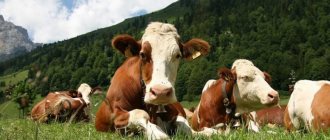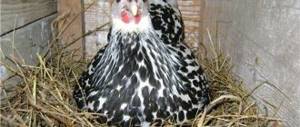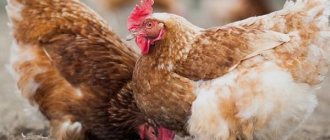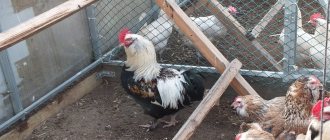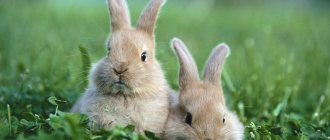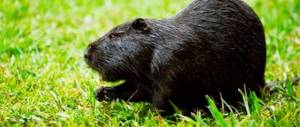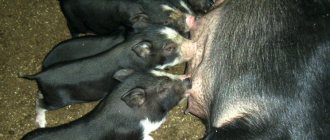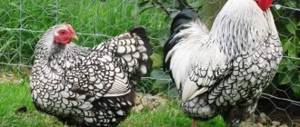Information about the origin of the breed
Homeland - Ukraine, Pologovskaya hatchery station. Scientists sought to create a universal breed of chickens that could boast high productive qualities and could grow and develop in small farms without special conditions. They were able to achieve their goal, and a stunning cross was born with excellent productive qualities and many other advantages.
At the moment, the breed is bred only in Ukraine, in Russia and abroad, few people know about it, but the breed still has everything ahead. The egg and meat characteristics of the laying hen are at the highest level; it is considered one of the best crosses. However, the main drawback: Avicolor is a hybrid, so not all descendants of the cross will be able to repeat the productive abilities of their parents.
To obtain purebred crosses, you must each time purchase eggs for the incubator at poultry farms; you will not be able to breed offspring yourself.
Avicolor chicken breed
Origin story.
The creators are breeders from the Pologovskaya hatchery station, which is located in Ukraine. The breeders had one task - to produce an unpretentious and at the same time productive layer, which would become universal and could be bred on private farms. They managed to achieve their goal, and a new variety was born, very productive and at the same time having a number of other advantages.
Unfortunately, the Avicolor breed of chickens has not gained much popularity in other countries, although perhaps it still has a long way to go. In its meat and egg category, the universal layer is considered one of the best. But we must not forget that this is a hybrid, not a breed, so subsequent generations will not be able to repeat their parents.
To renew the livestock, it will be necessary to purchase hatching eggs or baby chickens; it will not be possible to independently obtain genetically matched offspring.
Description of the bird
The external characteristics of the breed do not have specific features. Chickens look cute, their appearance does not repel or frighten poultry farmers.
The main characteristics of the Avicolor cross:
- the torso is proportional;
- massive body;
- flat back, round sides, chest more pronounced in females than in males;
- muscles are developed;
- thick plumage, with hard down;
- the tail is small, slightly raised, roosters have long braids;
- any color, but more often chickens are red, and roosters are white;
- the head is small, the neck is not wide;
- there are leaf-shaped combs on the top of the head;
- earrings are small;
- the skin is red and not wrinkled;
- oval-shaped ears, straight yellow beak;
- The paws are strong, thanks to them the bird can develop good speed.
Crosses never take part in exhibitions or fairs; they are bred to produce large quantities of eggs and meat.
Productivity
Avicolor crosses belong to the meat and egg groups, so they bring good results in both areas.
Puberty
The cross outshines other breeds of chickens created earlier by scientists. Birds are ready to lay eggs at the age of 3-4 months; puberty begins a little later. Thanks to this feature, choughs have attracted the attention of many poultry farm owners, since in this situation costs are significantly reduced, and entrepreneurs begin to make profits much earlier.
Egg production and meat yield
Crosses gain weight very quickly: at 2 weeks it is 250 g, per month - 0.7 kg, at 2 months - 1.8 kg. Every week, live weight increases by 200-300 g, and this is a very good indicator. This breed is kept not only for the production of a large number of eggs, but also for meat.
Due to their good productivity, crosses are popular on large farms, although they were created for small families. In the first year, the bird lays about 300 eggs, then the clutch decreases slightly.
Hatching instinct
It's no secret that crosses and hybrids lose their maternal instinct due to long-term crossings. However, Avicolor is an exception; hens can hatch not only their own eggs, but also those of others. This feature is important on small farms; as for large poultry farms, the brooding instinct is not used there.
Poultry farmers with extensive experience also recommend using an incubator on small farms, because during incubation, the bird stops laying eggs, and this will significantly affect their overall number.
More is written about incubating chicken eggs here.
Bird temperament
Laying hens are very active and loud. It is better not to keep birds in cages, but this is practiced in large poultry farms. Individuals feel good on a walk, in nature, then lay excellent eggs and serve farmers as meat birds with excellent taste.
Chickens are very curious, their character is reminiscent of children who are always interested in something and go wherever they want. But it is precisely because of this characteristic that chickens often get into trouble, so the goal of the farmer is to protect them from such trips.
Klushi are not afraid of anyone, are not sensitive and are not exposed to stress, and from an early age. They are not aggressive, are friendly and responsive, and can get along with any breed of chicken.
Breed productivity
Reviewing the productivity of rare Avicolor chickens, the qualities and features of keeping, the poultry farmer is interested in what he will get from the bird. As for live weight, males aged 1 year gain weight up to 3.5 kg. Chickens are smaller and lighter, weighing approximately 2-2.5 kg.
Young animals quickly gain weight with good fattening. Month-old chicks can grow up to 700 g, and at 2 months their weight will reach 1.5-1.8 kg. The meat is of high quality, pink in color when fresh, and after cooking it is juicy, soft, and tasty.
The breed is famous for its high egg production. First-year hens lay 280-300 eggs weighing 50 g per year, which not all ordinary laying hens can boast of. However, from the second year of life, the egg production rate decreases to 20-30%.
Important! You can achieve maximum egg production by feeding laying hens with complete feed, enriched with vitamins and mineral supplements.
Puberty begins early, chickens begin to lay eggs at 4-4.5 months. The first clutch is irregular, but after a month it becomes stable. The hen lays eggs every day, and breaks occur during the molt. This period is difficult for the bird; its body expends a lot of resources. To replenish them, chickens are given vitamins and microelements by mixing additives into the feed.
See also: Automatic chicken feeders - a godsend for breeders
Advantages and disadvantages of the Avicolor breed
Avicolor crosses, like other birds, have their advantages and disadvantages; they must be taken into account when breeding hybrids.
Advantages of Avicolor:
- high productivity;
- early egg laying and puberty;
- ease of care;
- calm character;
- rapid weight gain;
- presence of maternal instinct.
Disadvantages of Avicolor:
- short performance period;
- narrow distribution;
- difficulty in purchasing chicks.
Advantages and disadvantages of Avicolor chickens
Due to its numerous advantages, the Avicolor chicken breed has become a favorite for many Ukrainian farmers. She is valued for the following qualities:
- early onset of puberty;
- high egg productivity;
- rapid growth;
- friendly character;
- undemanding conditions of detention;
- good taste characteristics of meat;
- The sex of chickens can be determined immediately after they are born - hens have red down, and cockerels have light, almost white down.
Chickens have red down
The breed also has its disadvantages. The most significant disadvantage is that these chickens cannot be bred at home. When crossing a rooster and an Avicolor hen, the chickens will lose about 50% of their parental characteristics. The only way to get purebred chicks is to purchase hatching eggs or young animals from poultry farms. However, the problem is that these chickens are not common in Russia, and difficulties may arise in purchasing birds.
Attention! Avicolor hens show high egg production only in the first year of laying. Then productivity drops sharply. Farmers have to replace their livestock every 1.5–2 years.
Content Features
Cross Avicolor can be kept in a poultry house and in cages. Each of these options has its own characteristics; let’s consider them in more detail.
In a chicken coop with a walk
The chicken breed is characterized by active behavior and a curious disposition, so walking is what you need. In free, relaxed conditions, the bird will feel better, the quality of the meat will be excellent, and egg production will increase.
You don’t have to worry about cold winters; laying hens of this hybrid tolerate frost well, they are easy to care for, and do not require special living conditions.
Recommendations for creating an excellent chicken coop for Avicolor laying hens:
- Build a poultry house and insulate it well.
- Fill the floors with concrete or cover them with clay.
- Provide ventilation throughout the room.
- Double glazed windows are required.
- Install a walking yard covered with chain-link near the chicken coop.
- Insulate the floor in the room with straw, hay or dry leaves (it is recommended to use bacterial bedding).
- Set up perches and nests (like a box of straw or hay).
- At the beginning of the autumn period, treat the chicken coop, regularly ventilate the room, change the bedding.
For 1 sq. m. there should not be more than 2 chickens.
- Build a chicken coop 2 m high. If it is higher, then it is difficult to warm the house in winter, and if it is lower, then it is more difficult to ventilate in summer.
- Maintain the temperature at +22...+25 degrees Celsius, in winter at least +15 degrees.
You can learn how to properly heat a chicken coop in winter from this article.
In cells
Avicolor crosses are characterized by excessive activity, so it is very difficult to cage birds. It is possible to keep chickens in this form only if they are accustomed to this from birth.
How to build a cage for laying hens with your own hands is described in another article.
Rules for keeping the breed in cages:
- For 1 sq. m – about 5-8 birds. This indicator may vary depending on the weight of the chickens.
- For 1 hen – 10 cm feeder.
- Watering: 5 birds per 1 nipple.
- Monitor ventilation; fans are used on a large scale.
- The temperature should vary from +15...+18 degrees, if it rises too much, then the birds reduce egg laying and sometimes die from the heat.
Features of keeping crosses
Even a beginner can take care of Avicolor chickens. Birds do not require much attention; they only need a cozy house and a walking yard. When it comes to nutrition, chickens are undemanding - they are fed homemade mash, grains and vegetables.
How to set up a chicken coop: recommendations
The barn is built on a hill so that it is not flooded by water during rainstorms or melting snow. The floor is reliably protected from the penetration of rodents, the walls are insulated with mineral wool or polystyrene foam. The chicken coop should have a window. It is advisable to install electricity into the room so that in winter it is possible to artificially regulate the length of daylight hours. It is 12 hours.
Setting up a chicken coop
The health and productivity of birds depends on the microclimate in the chicken coop. It is important to provide good air exchange by installing a supply and exhaust ventilation system. Some farmers neglect this requirement, which leads to a decrease in egg production in chickens and a weakening of their immunity.
Attention! When humidity is high, birds often get sick, and due to ammonia vapors accumulating in the room, chickens develop night blindness.
Avicolor chickens feel comfortable at temperatures from +8 to +25 ºС. In the southern regions, birds can live in an unheated barn. Farmers from the middle zone should take care of heating the chicken coop. The floor is covered with a thick layer of sawdust with the addition of peat. As the litter gets dirty, turn it over to its full depth, and once a month 5 cm of fresh shavings are placed on top.
Reference. Twice a year, in spring and autumn, the underlying material is replaced. At the same time, a general cleaning is done in the chicken coop - the walls and floor are coated with lime, the room is treated with a sulfur bomb, and all equipment is disinfected.
Perches for night rest are installed at a height of 80 cm. For convenience, they are equipped with gently sloping wooden stairs, along which the hens climb and descend. The recommended pole length for 1 bird is 30–35 cm. Nests will be needed for chickens. You can use wooden boxes covered with straw. They are installed in a dark place in the barn, protected from drafts.
Chicken feeder
Nipple or vacuum drinkers and a feeder are placed on the floor. Each bird should be able to approach it from any direction. The length of the feed tape for an adult is 20 cm. To prevent infection by ectoparasites, a trough or large basin with sand and ash is installed in the chicken coop. Chickens bathe in this dust, cleaning their feathers.
Aviary for walks
Active and inquisitive Avicolor chickens need daily walking. You will have to build an enclosure for them or fence off part of the yard with a metal mesh. It is good if the upper part of the paddock is at least partially equipped with a canopy that protects from the scorching sun and precipitation.
The area of the enclosure is calculated based on the number of livestock. Each bird should have at least 1 m2 of free space. Representatives of the Avicolor breed can take off. To prevent them from flying away through the fence, it is made high - 1.8 m.
In spring and summer, walking is not limited. Birds stay in the fresh air from morning until dusk. With the onset of cold weather, the chickens are released briefly during the daytime, when the air warms up a little. It is impossible to completely deprive laying hens of walking - being constantly indoors, they experience stress, which reduces productivity.
Aviary for chickens
In winter, the duration of walks is reduced to 1 hour. Although the plumage of Avicolor chickens is dense and dense, at temperatures below –8 ºС they can freeze their combs and paws. In addition, exposure to strong winds in damp weather leads to colds.
Features of diet preparation
Representatives of the Avicolor breed line are undemanding when it comes to food supply. They eat whatever the farmer offers. However, for high egg production and rapid muscle growth, birds need protein and mineral supplements. The diet includes:
- various grains - millet, millet, barley, buckwheat, corn;
- beans - peas, lentils;
- greens - onions, nettles, dandelion leaves, alfalfa, plantain, garden tops;
- vegetables - carrots, cucumbers, zucchini, pumpkin, fodder beets;
- fermented milk products – low-fat cottage cheese, whey;
- boiled fish 1-2 times a week.
Attention! Chickens that lay a lot of eggs need calcium. Its sources are eggshells, chalk, and shell rock.
Vitamin and mineral supplements are introduced into the diet of birds - bone and fish meal, yeast, fish oil. In winter, when there is no access to fresh herbs, birds are given purchased herbal pellets.
Herbal pellets for chickens for the winter
It is very important to properly organize the feeding regimen. In summer, the feeder is filled in the morning and evening. During the daytime, laying hens are out for a walk; they peck at worms, insects, and greens. In winter, poultry is fed 3 times a day. At lunch, warm, moist mash based on broth or whey is prepared for them. They add grain, chopped vegetables, and dried herbs.
Disease Prevention
Avicolor chickens have strong immunity, so they rarely get sick. Health problems for these birds sometimes arise if the farmer does not keep the chicken coop clean and violates feeding rules. Common diseases:
- Vitamin deficiencies - develop due to a poor diet, lack of vitamins A, E, D.
- Salpingitis, or inflammation of the oviduct, occurs in pullets that begin to lay eggs too early. The factor that provokes the disease is a violation of the light regime in the chicken coop.
- Knemidocoptic mange is damage to the skin of the paws and cloaca by mites. The disease can be recognized by a change in the color of the metatarsus - they become covered with white spots. Later, irregularly shaped bumps appear on the chickens' legs.
- Cloacitis is an inflammation of the cloaca. The cause of the disease is the predominance of protein foods in the diet and a lack of vitamins.
- Rickets - occurs in young animals. Chicken bones become soft and deformed. This occurs due to vitamin D deficiency.
A sick chicken looks depressed
In order for chickens to remain healthy and highly productive, you need to carefully monitor the cleanliness of the barn, regularly remove droppings from the litter, and disinfect them. This will help reduce the likelihood of infectious and parasitic diseases. You will also have to learn how to properly create a menu for laying hens. Their diet should be varied.
How to care for the breed?
Particular attention should be paid to birds during molting. Although this is a common occurrence, the laying hen still does not feel very well. Seasonal molting leads to a decrease in egg production. This stage lasts about 2 months in the fall. During this period, unpleasant phenomena caused by a lack of vitamins and minerals may occur.
Birds begin to peck each other, some peck themselves. To avoid this, more healthy microelements are added to the menu, dishes rich in vitamins, fats and natural fats.
These birds are not characterized by long-term productivity; already in the third year their performance deteriorates significantly. The maximum period for keeping crosses is 2 years. In large-scale poultry farms, the chicken coop is replenished with new stock every year to make poultry production even more profitable.
Features of maintenance and cultivation
Avicolors are undemanding to living conditions.
On protein feed, chickens quickly gain the weight they need for slaughter and begin to lay eggs earlier.
Many Avicolor breeders have noticed that their egg production increases significantly when the correct light regime is observed. Birds should be allowed into the yard periodically so they can get some fresh air.
Chickens do not require special housing conditions. They get along in chicken coops with a place for walking, in cages at poultry farms. They do not conflict with other breeds.
The chicks acquire feathers very quickly, they have a good appetite and eat most foods well. These birds are fed like the rest of the chicken family. The diet for the new breed has not yet been developed, so they are fed grain and wet mash.
When birds live at home with a normal diet, they rarely manage to gain normal weight. Many farmers make recommendations for feeding chickens with professional feed. You can offer table scraps, but without chemicals.
The light regime plays a major role in breeding the breed. If followed correctly, egg productivity will greatly please farmers. In daylight, hens lay more eggs. But it is also necessary to observe the light regime correctly. With constant daylight, the hens will be exhausted and egg laying will stop completely.
Chickens of this breed have early maturity. At four months the hen begins to make a profit. Avicolors have a very well developed maternal instinct. This is an important factor, because most of the bred crosses do not have it at all due to selection experiments. Laying hens themselves hatch the eggs and take excellent care of the young.
Quantitative data
The total weight of Avicolor roosters is 2.5-3 kg. Laying hens of this breed can gain weight up to 2.5 kg. At the age of 28 days, chickens reach a weight of 700 g, and at the age of 42 days - already 1300 g.
Chickens of this breed begin laying eggs for the first time at the age of 3.5 months. On average, they can lay over 300 eggs in their first year of production. Each egg in a clutch of Avicolors weighs 50 grams, but for incubation it is better to choose the largest specimens.
Source: greenologia.ru
Feeding Basics
The Avicolor chicken breed is undemanding in terms of nutrition, but without a large amount of nutritious feed, the poultry farmer will not get high results from poultry.
Adults
Crosses need protein, so the feed must contain it. Thanks to this protein, birds quickly gain weight and also maintain egg production at a high level.
The main role is played by the feeding regime; if the birds eat according to a schedule, then their body will function without interruption.
Since crosses are not whimsical, you can choose any food - from factory-made to home-made. You can create your own food; it should include cereals, grains, sprouted wheat, herbs and vegetables. In the summer, the supply of fresh greens is important. In winter, add dry grass to your food, which includes vitamins and minerals.
Chickens
Avicolor babies develop very quickly and gain weight; at about the age of 1 month, an individual already weighs 1 kg. Selecting food is not difficult; it consists of a boiled egg and crushed cereals - millet or semolina. As the chicks grow older, they are switched to an adult diet.
Avicolor hens are excellent mothers, so caring for the chicks will not be difficult.
Feeding ration
Without enough balanced feed, you will not get the full benefit from any poultry. Avicolor is no exception, although it is considered quite undemanding in terms of nutrition.
Adult chickens
The feeding diet of Avicolor chickens is based on the use of special balanced feeds containing a high level of proteins. This is necessary to maintain a high level of productivity and also to ensure that the chickens gain good weight.
When feeding adults, you should develop a feeding regimen. If the birds eat according to the schedule, their body will work smoothly, which has a positive effect on the regular and productive laying of eggs.
This breed is unpretentious in its choice of food. The food can be anything - from factory-made dry food to homemade food (porridge, grain, sprouted wheat, vegetables, herbs).
It is necessary to carefully monitor the intake of all necessary vitamins and minerals into the birds’ bodies. For this purpose, walking on green grassy lawns in warm weather is very useful. During the winter period, every day it is necessary to include dry grass in the diet, as well as special complex preparations containing the necessary beneficial elements.
Chickens
Chickens of this breed develop quickly and gain weight. At 28 days their weight is approximately 1 kg.
Selecting a diet for the offspring of chickens is not difficult. It starts with a boiled egg and regular small cereals. As the chicks grow, they switch to adult food.
It should be noted that hens of this breed are excellent and caring mothers. Therefore, caring for the chicks will not be difficult.
Breeding
Reproduction of Avicolor crosses is difficult; the offspring of hybrids do not always repeat the productive characteristics of their parents, so it is impossible to breed them in your own yard.
Farmers buy eggs for the incubator at special poultry farms, and you can also purchase chickens of various ages. The cost for eggs is minimal, and for birds over 4 months old – the maximum. The chicks are born healthy and strong, they are not afraid of climate change, living conditions or sharp sounds and screams.
The survival rate is approximately 95%, which indicates the good vitality of the chicks.
Diseases and pests
It is necessary to take care of the livestock every day, so it is important to carry out preventive measures to help avoid the occurrence of viruses or pest infestations. Individuals of the Avicolor breed can boast of strong immunity, but some problems can disable them for a long time.
As mentioned earlier, chickens are very active in laying eggs, producing more than 300 eggs per year, they risk their health. They often suffer from a lack of vitamins and physical exhaustion. Such ailments significantly worsen the immune system, so it is necessary to give the birds vitamins and minerals on time. In addition, birds also suffer from parasites, but to get rid of them, farmers install containers with ash in poultry houses and in the walking yard.
Advantages and disadvantages of the breed
We have already said a lot about the advantages of this cross. Let's summarize the description:
- tasty and tender meat;
- rapid ripening;
- can be kept in cages and small poultry houses;
- egg production - 300 eggs per year or more;
- diligent hatching of offspring and care for chickens;
- unpretentiousness to feed and weather conditions;
- peaceful behavior in the barn.
One of the disadvantages is their low weight, but in order to have more meat from Avicolor, their number in the poultry house can simply be increased. Is not it? Therefore, in our opinion, these chickens will never be superfluous on the farm. And if there are hens among them, feel free to place eggs under them, and then rejoice at the replenishment!
Analogs
The most famous analogue of Avicolor is Super Harko chickens. They are considered to be of meat and egg origin. Birds are kept both in a chicken coop and in a cage, and they do not stop producing eggs. The Super Harko breed is very popular in the villages of Ukraine; they are bred by almost all large-scale farms in the state.
Reviews from poultry farmers about Avicolor chickens
★★★★★
Alina, 38 years old, designer, Kiev. A couple of years ago, my mother wanted to breed broilers, and I wanted to find her birds that were already grown up.
At that moment, the seller offered to purchase Avicolor individuals. I decided to take a chance and bought one dozen. I came home and read that they will start laying eggs at 4-5 months. Previously, we only had domestic chickens, so it seemed to me that this was a hoax and this couldn’t happen. But imagine my surprise when, at the age of 4 months, they began to lay eggs. As I remember now, the first egg was long, and there were 2 yolks inside. ★★★★★
Ivan, 42 years old, salesman, St. Petersburg. It is simply unrealistic to buy chickens of this breed on our territory.
So this is despite the fact that I have a friend who works at a poultry farm, whoever he has there, but these crosses were missing. Some time later I ordered chickens from Ukraine. To this day they order from the same person, I can’t get another breed, I fell in love with Avicolor so much, plus they completely correspond to my desires. Hide
Add your review
Avicolor crosses are unpretentious birds of universal purpose. They are distinguished by high egg production and rapid weight gain. They can boast of having maternal instinct and early puberty. Chickens are unpretentious and have a good calm character.
0
0
Copy link
Origin of the Avicolor chicken breed
The line was bred by Ukrainian breeders in the east of the country, at the Pologovskaya hatchery station, which is located in the Zaporozhye region. Scientists set themselves the goal of creating highly productive poultry that is undemanding in terms of housing conditions and food supply. Egg-laying native hens and Super Harko, meat-producing chickens, took part in the selection.
The result exceeded the scientists' expectations - the new breed not only met the stated requirements, but also acquired other valuable qualities:
- early puberty;
- calm temperament;
- the ability to rapidly gain weight.
The breed is little known in Russia, but is popular in its homeland. In eastern Ukraine it can be found in every village.
Attention! The Avicolor hybrid does not pass on its productive qualities well to its descendants. To obtain purebred chicks, you will have to buy young animals or hatching eggs each time.
